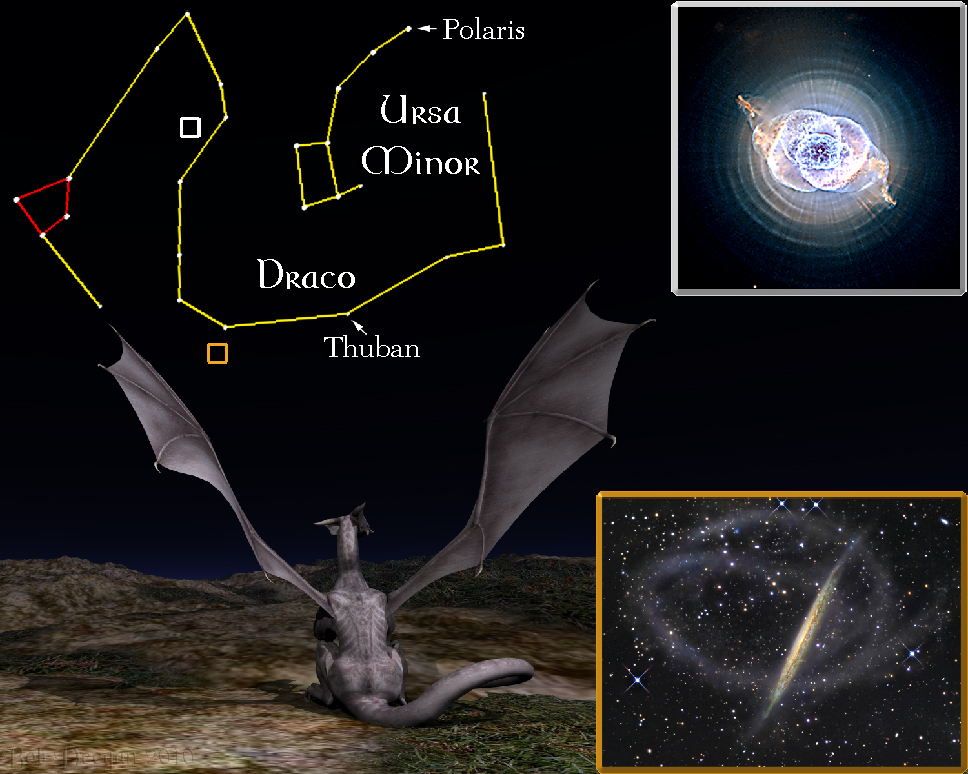
For the week including December 3, 2010

DRACO, THE DRAGON
One of the oldest known constellations, Draco, the Dragon has been around since the star maps of the ancient Babylonians and Sumerians. Because most of the Dragon’s stars are pretty faint, it can be a little difficult to spot among the other stars that make up the northern sky.
To start the search, face toward the horizon where the Sun went down, then turn right. You’re now facing north. To locate the constellation of the Dragon, we can start at Polaris, the North Star. Polaris marks the end of the handle of the Little Dipper which is also the constellation of Ursa Minor, the Lesser Bear. Polaris isn’t very luminous, but it’s a good deal brighter than any nearby.
Winding around Ursa Minor are the faint stars of Draco’s tail; follow them along and you will come to the four prominent stars that mark the Dragon’s head (highlighted in red in our illustration). Once you’ve found Draco, you’ll have no trouble pinpointing its stars again. The serpentine trail of its stars is distinctive in the sky. The Dragon used to be home to the “North Star” when the ancient Egyptians were building their magnificent pyramids. Thuban lost this distinction because of a slow wobble in the Earth’s rotation called precession. As our planet gradually totters through the 26,000 years of its precession, our North Pole gets pointed towards other areas of space and we get new Pole stars to help us find our way. It will take some 21,000 years before Thuban will regain the title of Pole Star.
The Cat’s Eye Nebula: In the Hubble Space Telescope photograph at upper right, we see a star in the last stages of its life, sloughing off its outer layers in a series of explosions. The debris is made to glow by ultraviolet radiation emanating from the hot core of the central star. The Cat’s Eye is one of the brightest examples of what astronomers call a planetary nebula. This nebula is pretty close to us at a distance of 3,000 light years and is fairly new as well. Its host star began casting these colorful clouds into space some 1,000 years ago.
NGC 5907, The Splinter: Through a telescope, the Splinter looks like a surreal streak of light against the blackness of space. The photograph at lower right shows that the Splinter is a spiral galaxy like our Milky Way. But, because it’s oriented almost edge-on toward Earth, the Splinter presents us with a beautiful but narrow view. The coiling streamer of stars surrounding NGC 5907 is the remains of a smaller galaxy that wandered too near to escape the Splinter's gravitational pull. Pulled and stretched over millions of years, nothing remains of the encounter but a soft blur of stars from the trapped galaxy and a slight wobble in the disk of its absorbing host.
The photograph of NGC 5907 is by R Jay Gabany with D.Martínez-Delgado, J.Peñarrubia, I. Trujillo, S.Majewski, and M.Pohlen
Unless otherwise indicated, all content of this web site is the copyright of Robert Deegan and all rights are reserved.
For more information, or to comment, please contact: Bob@NightSkies.org